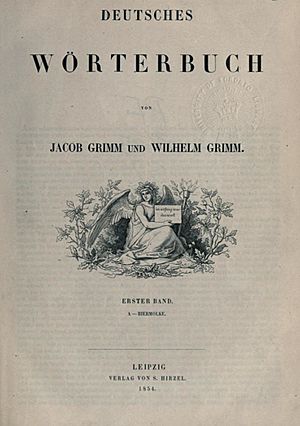Deutsches Wörterbuch facts for kids
The Deutsches Wörterbuch ( "The German Dictionary"), abbreviated DWB, is the largest and most comprehensive dictionary of the German language in existence. Encompassing modern High German vocabulary in use since 1450, it also includes loanwords adopted from other languages into German. Entries cover the etymology, meanings, attested forms, synonyms, usage peculiarities, and regional differences of words found throughout the German speaking world. The dictionary's historical linguistics approach, illuminated by examples from primary source documents, makes it to German what the Oxford English Dictionary is to English. The first completed DWB lists over 330,000 headwords in 67,000 print columns spanning 32 volumes.
The Deutsches Wörterbuch was begun by the Brothers Grimm in 1838 and the initial volumes were published in 1854. Unfinished at the time of their deaths, the dictionary was finally completed by a succession of later scholars and institutions in 1961. In 1971, a 33rd supplement volume was published containing 25,000 additional entries. New research projects began in 2004 to expand and update the oldest parts of the dictionary to modern academic standards. Volumes A–F were planned for completion in 2012 by the Language Research Centre at the Berlin-Brandenburg Academy of Sciences and Humanities and the University of Göttingen.
Later versions
Planning for a second edition already began in 1957, four years before the first edition was finished. The revision was intended especially to bring the oldest part of the Dictionary, the letters A-F originally authored by the Brothers Grimm, up to date. It also was to be a cooperative effort between East-West: the Academy of Sciences of the GDR in East Berlin would complete A-C, and the University of Göttingen in the West would complete D-F. The initial fascicles of this revision were published in 1965, but it remains unfinished today, with the letters B and C (originally assigned to the Berlin team) still in progress. Work on the project in East Germany was greatly hindered for political reasons because the DWB was regarded as a "bourgeois" lexicography project. In the course of the sixties, most of its staff were taken off the project and used for other tasks. In 1984, the original 1961 version of the DWB was published in a paperback edition, now out of print. In 1999 a new paperback printing of all 33 volumes (weight 30 kg), published by Deutscher Taschenbuch Verlag, became available.
Digital edition
In 2004 the Competence Center for Electronic Text Processing and Publication in the Humanities at the University of Trier digitized the entire 300 million printed characters according to the method of double entry. The entire body was manually entered twice in China to eliminate error. A set of CD-ROMs of this digitization was released for Microsoft Windows, Linux and Mac OS. In this version spelling errors in the original were corrected. An online version of the first edition is also available at the University of Trier. The digitized first edition of the DWB met with lively interest. Every day the online version receives tens of thousands of hits and the CD-ROM of the first edition is now in its fourth updated distribution.
New edition
In 2006 the unfinished project to revise and update the A-F volumes to modern academic standards was resumed. The conclusion of this work (the B and C volumes) was finished in 2016; fascicles are appearing with the S. Hirzel Verlag as they are completed.
However, the Berlin-Brandenburg Academy of Sciences and Humanities announced that no revision of the volumes G to Z is planned. According to the Academic Director of the Berlin-Brandenburg Academy, Wolf-Hagen Krauth, the sheer labor that would be required exceeds the possibilities for funding it in today's world.
Images for kids
-
Original manuscript of the Deutsches Wörterbuch by Jacob Grimm
-
East German commemorative stamp, 1975
See also
 In Spanish: Deutsches Wörterbuch para niños
In Spanish: Deutsches Wörterbuch para niños





